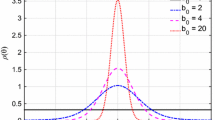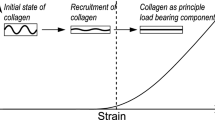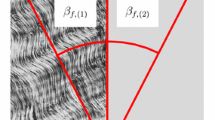Abstract
Arteries are prominent organs composed of soft tissues which have to distend in response to pulse waves. Once it is possible to develop reliable mechanical models of these soft tissues, a better understanding of several cardiovascular diseases, such as atherosclerosis, and interventional treatments, such as balloon angioplasty, might be possible. Numerical simulations which are based on realistic and efficient mechanobiological models could help to find optimal medical treatment strategies against diseases and injuries. In order to obtain reliable models of blood vessels, one aim is to describe the concentration and structural arrangements of collagen fibers in the associated soft tissue. A new approach for an automatic structural analysis of collagen in the outermost layer of the human blood vessel, i.e., the adventitia (tunica externa), is proposed. The method uses light microscopic images of thinly sliced tissue samples for data extraction. Robust clustering in the RGB space and morphological operations are used to select fiber regions and mask non-fiber regions. Based on ridge and valley detections, the fiber orientations of small fiber patches are robustly calculated. Finally, region growing is used to combine the fiber patches to regions of a homogeneous fiber orientation. Experimental results demonstrate the accurate fiber orientation detection. The extracted data are intended to be used in biomechanical models for blood vessels.


















Similar content being viewed by others
Notes
This is a standard embedding material in histology.
This is a standard stain in histology.
References
Humphrey JD (2002) Cardiovascular solid mechanics: cells, tissues, and organs. Springer, Berlin Heidelberg New York
Holzapfel GA, Gasser TC, Ogden RW (2000) A new constitutive framework for arterial wall mechanics and a comparative study of material models. J Elast 61:1–48
Holzapfel GA, Gasser TC, Stadler M (2002) A structural model for the viscoelastic behavior of arterial walls: continuum formulation and finite element analysis. Eur J Mech A–Solids 21:441–463
Holzapfel GA, Gasser TC, Ogden RW (2004) Comparison of a multi-layer structural model for arterial walls with a Fung-type model, and issues of material stability. J Biomech Eng 126(2):264–275
Holzapfel GA (2004) Computational biomechanics of soft biological tissue. In: Stein E, de Borst R, Hughes TJR (eds) Encyclopedia of computational mechanics. Wiley, Chichester, UK
Hibbard LS, McKeel DW Jr (1995) Multiscale detection and analysis of the senile plaques of Alzheimer’s disease. IEEE Trans Biomed Eng 42:1218–1225
Esgiar AN, Naguib RNG, Sarif BS, Bennett MK, Murray A (1998) Microscopic image analysis for quantitative measurement and feature identification of normal and cancerous colonic mucosa. IEEE Trans Inf Technol Biomed 3:197–203
Ferrari RJ, Rangayyan RM, Desautels JEL, Frère AF (2001) Analysis of asymmetry in mammograms via directional filtering with gabor wavelets. IEEE Trans Med Imaging 20:953–964
Suri J, Setarehdan K, Singh S (eds) (2001) Advanced algorithmic approaches to medical image segmentation: state-of-the-art applications in cardiology, neurology, mammography and pathology. Springer, Berlin Heidelberg New York
Di Ruberto C, Dmpster A, Khan S, Jarra B (2002) Analysis of infected blood cell images using morphological operators. Image Vis Comput 20:133–146
Ferdman AG, Yannas IV (1993) Scattering of light from histologic sections: a new method for the analysis of connective tissue. J Invest Dermat 100:710–716
Billiar KL, Sacks MS (1997) A method to quantify the fiber kinematics of planar tissues under biaxial stretch. J Biomech 30:753–756
Sacks MS, Smith DB, Hiester ED (1997) A small angle light scattering device for planar connective tissue microstructural analysis. Ann Biomed Eng 25:678–689
Sellaro TL (2003) Effects of collagen orientation on the medium-term fatigue response of heart valve biomaterials. Master’s thesis, School of Engineering, University of Pittsburgh, Pennsylvania
Hilbert SL, Sword LC, Batchelder KF, Barrick MK, Ferrans VJ (1996) Simultaneous assessment of bioprosthetic heart valve, biomechanical properties, and collagen crimp length. J Biomed Mater Res 31:503–509
Finlay HM, Whittaker P, Canham PB (1998) Collagen organization in the branching region of human brain arteries. Stroke 29:1595–1601
Baer ET, Gathercole LJ, Keller A (1974) Structure hierarchies in tendon collagen: an interim summary. In: Atkins ET, Keller A (eds) Structure of fibrous biopolymers. In: Proceedings of the 26th symposium of the Colston Research Society, Bristol, UK, April 1974, pp 189–195
Gathercole LJ, Keller A (1991) Crimp morphology in the fibre-forming collagens. Matrix 11:214–234
Geday M, Kaminsky W, Lewis J, Glazer A (2000) Images of absolute retardance L·Δn using the rotating polariser method. J Microscopy 198:1–9
Tower TT, Neidert MR, Tranquillo RT (2002) Fiber alignment imaging during mechanical testing of soft tissues. Ann Biomed Eng 30:1221–1233
Massoumian F, Juškaitis R, Neil MAA, Wilson T (2003) Quantitative polarized light microscopy. J Microscopy 209:13–22
Axer H, von Keyserlingk DG, Prescher A (2001) Collagen fibers in linea alba and rectus sheaths: I. General scheme and morphological aspects. J Surg Res 96:127–134
Axer H, Graf v. Keyserlingk D, Prescher A (2001) Collagen fibers in linea alba and rectus sheaths: II. Variability and biomechanical aspects. J Surg Res 96:239–245
Young AA, Legrice IJ, Young MA, Smaill BH (1998) Extended confocal microscopy of myocardial laminae and collagen network. J Microscopy 192:139–150
Rhodin JAG (1967) The ultrastructure of mammalian arterioles and precapillary sphincters. J Ultrastruct Res 18:181–223
Somlyo AP, Somlyo AV (1968) Vascular smooth muscle: I. Normal structure, pathology, biochemistry, and biophysics. Pharmac Rev 20:197–272
Walmsley JG, Canham PB (1979) Orientation of nuclei as indicators of smooth muscle cell alignment in the cerebral artery. Blood Vessels 16:43–51
Peters MW, Canham PB, Finlay HM (1983) Circumferential alignment of muscle cells in the tunica media of the human brain artery. Blood Vessels 20:221–233
Todd ME, Laye CG, Osborne DN (1983) The dimensional characteristics of smooth muscle in rat blood vessels: a computer-assisted analysis. Circ Res 53:319–331
Xia Y, Elder K (2001) Quantification of the graphical details of collagen fibrils in transmission electron micrographs. J Microscopy 204:3–16
Wu J, Rajwa B, Filmer DL, Hoffmann CM, Yuan B, Chiang C, Sturgist J (2003) Automated quantification and reconstruction of collagen matrix from 3D confocal datasets. J Microscopy 210:158–165
Glazer F (1992) Fiber identification in microscopy by ridge detection and grouping. In: Proceedings of the IEEE workshop on applications of computer vision, Palm Springs, California, November/December 1992, pp 205–212
Eberhardt CN, Clarke AR (2002) Automated reconstruction of curvilinear fibres from 3D datasets acquired by X-ray microtomography. J Microscopy 206:41–53
Clarke AR, Eberhardt CN (2002) Microscopy techniques for materials science. Woodhead Publishing/CRC Press LCC, Boca Raton, Boston, Massachusetts
Rhodin JAG (1980) Architecture of the vessel wall. In: Bohr DF, Somlyo AD, Sparks HV (eds) Handbook of physiology: the cardiovascular system, vol 2. American Physiological Society, Bethesda, Maryland, pp 1–31
Mahalanobis PC (1936) On generalized distance in statistics. Proc Nat Inst Sci (India) 12:49–55
Duda RO, Stork DG, Hart PE (2000) Pattern classification, 2nd edn. Wiley, New York
Huber PJ (1981) Robust statistics. Wiley, New York
Sonka M, Hlavac V, Boyle R (1999) Image processing, analysis, and machine vision, 2nd edn. CRC Press, Boca Raton, California
Gonzalez RC, Woods RE (2002) Digital image processing, 2nd edn. Prentice-Hall, New Jersey
López AM, Lumbreras F, Serrat J, Villanueva JJ (1999) Evaluation of methods for ridge and valley detection. IEEE Trans Pattern Anal Mach Intel 21:327–335
Gradshteyn IS, Ryzhik IM (2000) Tables of integrals, series, and products, 6th edn. Academic Press, San Diego, California
Russ JC (1999) The image processing handbook, 3rd edn. CRC Press, Boca Raton, California
Fisher NI (1993) Statistical analysis of circular data. Cambridge University Press, Cambridge, UK
Jammalamadaka SR, Gupta AS (2001) Topics in circular statistics. World Scientific, Singapore
Oppenheim AV, Schafer RW, Buck JR (1999) Discrete-time signal processing, 2nd edn. Prentice-Hall, Upper Saddle River, New Jersey
Rao AR (1990) A taxonomy for texture description and identification. Springer, Berlin Heidelberg New York
Kropatsch WG, Bischof H (eds) (2001) Digital image analysis. Springer, Berlin Heidelberg New York
Acknowledgements
Financial support for this research was provided by the Austrian Science Foundation under START-Award Y74-TEC and by the Amt der Steiermärkischen Landesregierung – Abteilung für Wissenschaft und Forschung. The first author was supported by a doctoral scholarship program granted by the Austrian Academy of Sciences. These supports are gratefully acknowledged.
Author information
Authors and Affiliations
Corresponding author
Rights and permissions
About this article
Cite this article
Elbischger, P.J., Bischof, H., Regitnig, P. et al. Automatic analysis of collagen fiber orientation in the outermost layer of human arteries. Pattern Anal Applic 7, 269–284 (2004). https://doi.org/10.1007/s10044-004-0224-3
Received:
Accepted:
Published:
Issue Date:
DOI: https://doi.org/10.1007/s10044-004-0224-3




